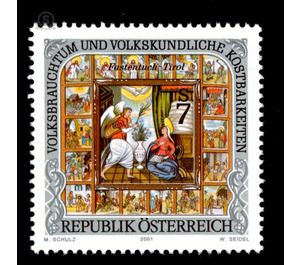folklore - Austria / II. Republic of Austria 2001 - 7 Shilling
Theme: Art & Culture
| Country | Austria / II. Republic of Austria |
| Issue Date | 2001 |
| Face Value | 7.00 |
| Edition Issued | 2,700,000 |
| Printing Type | combination printing |
| Stamp Type | Commemorative |
| Item Type | Stamp |
| Chronological Issue Number | 1686 |
| Chronological Chapter | OOS-OE2 |
| SID | 103313 |
| In 53 Wishlists | |
So-called "fast cloths" are supposed to veil the altar in Lent, because, according to medieval opinion, the penitent man would not be worthy to see God. The custom came in the 10th century, found its widest dissemination in the late Middle Ages, was pushed back by the Reformation and by Josephinian aspirations and experienced today, especially in our area a veritable renaissance. Originally the single-colored cloths were later embroidered or painted. A particularly well-painted, 32 m2 cloth from 1640, which was recently restored by the Federal Monuments Office, is located in the Museum of Folklore in Laudongasse 15-19, in Vienna's 8th district. In 36 fields, the whole of salvation, including the Assumption and the Coronation of Mary, is depicted in the style of a picture Bible. The whole cloth on a stamp is obviously not possible. The brand artist Maria Schulz shows after an outstanding idea on her draft a section: it focuses on the Annunciation Scene, the Archangel Gabriel and Mary and surrounds this representation with another 18 reduced to a quarter fields, from the creation of man to the Entombment of Christ.


